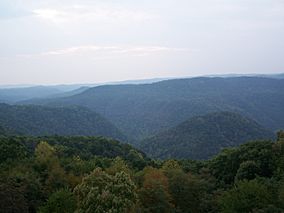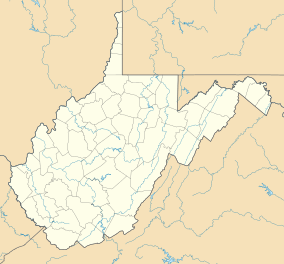Bluestone National Scenic River facts for kids
Quick facts for kids Bluestone National Scenic River |
|
|---|---|
|
IUCN Category V (Protected Landscape/Seascape)
|
|

Bluestone Gorge near the upstream end of the National Scenic River section.
|
|
| Location | West Virginia, United States |
| Elevation | 1,637 ft (499 m) |
| Established | 1988 |
| Operator | New River Gorge National River |
| Website | Bluestone National Scenic River |
The Bluestone National Scenic River is a special protected area. It covers about 10.5 miles (17 km) of the Bluestone River. This beautiful river flows through Summers and Mercer counties in southern West Virginia. It became a protected area on October 26, 1988. The National Park Service helps to keep it safe and natural.
The Wild and Scenic Rivers System was created to protect important rivers. These rivers are kept wild and free-flowing. They have amazing natural beauty, history, and fun things to do. This system makes sure these rivers are safe for us now and for the future. Over 150 rivers or parts of rivers are protected this way.
A section of the Bluestone National Scenic River is also protected. It is part of the West Virginia State Park System. This section is found within Pipestem Resort State Park. Another part is within a West Virginia Wildlife Management Area.
| Top - 0-9 A B C D E F G H I J K L M N O P Q R S T U V W X Y Z |
What Makes the Bluestone River Special?
The Bluestone River flows through a rugged gorge. This area is part of the southern Appalachian Mountains. It is a very diverse and beautiful place.
Plants and Animals
More than a thousand types of plants grow here. You can find many different kinds of Appalachian forest habitats. About 200 different kinds of birds have been seen in the park. The Bluestone also has many mammals, amphibians, reptiles, and insects.
The riverbed itself is full of tiny water creatures. It also has many healthy populations of fish. The state of West Virginia calls the Bluestone River a "High Quality Warm Water Stream." This means its water is very clean and good for fish.
River's Journey
The Bluestone River starts high up at 3,500 feet (1,067 meters). This is on East River Mountain near Bluefield, Virginia. It then flows for 77 miles (124 km). The river ends at Bluestone Lake near Hinton, West Virginia. Here, the elevation is 1,409 feet (429 meters).
A Look Back: History of the Bluestone River
The Bluestone River has a long and interesting history. People have lived near it for thousands of years.
Early Inhabitants
American Indians called the river "Momongosenka." This means "Big Stone River." They likely named it because of the many boulders in the lower gorge. Many ancient sites have been found along the river. These sites show where people lived and hunted.
Some sites date back to the Ice Age. This was when mammoths and mastodons roamed the land. Later, tribes like the Delaware, Cherokee, and Shawnee lived here. They were present in the 17th and 18th centuries.
European Settlers
In the mid-1700s, European and African people began to explore the river. They started to build homes and farms along its banks. Settlers at the river's start, in present-day Tazewell County, Virginia, named it "Bluestone." They did this because the water flowed over blue limestone rocks.
A community called Lilly once thrived near the river. It was located where the Bluestone and Little Bluestone rivers meet. However, the town was removed before the Bluestone Dam was built.
The Bluestone Turnpike
The Bluestone Turnpike is a road along the riverbank. It was once an old Indian trail. Local people used it until the 1940s. They used it to farm and cut timber in the area. Today, this turnpike is the main trail for park visitors.
In 2008, the Bluestone National Scenic River was chosen for a special event. It hosted the 40th anniversary celebration of the Wild and Scenic River System. This marked an important moment in American environmental protection.
Fun Things to Do and How to Visit
Getting to the Bluestone National Scenic River can be a bit tricky. It lies in a deep gorge with no direct road access.
How to Get There
The best ways to enter the area are at its ends. At the downstream end, you can enter through Bluestone State Park. At the upstream end, you can ride a special aerial tram. This tram is at Pipestem Resort State Park. It takes visitors down to the bottom of the gorge.
Trails and Water Activities
A hiking trail called the Bluestone Turnpike Trail runs along the river. It goes through the entire National Scenic River section. You can also go canoeing and kayaking. The best time for this is in the spring. This is when the water levels are usually high enough. The Pipestem Tram can even carry canoes, kayaks, and bicycles for a small fee.
Fishing and Hunting
Fishing is a very popular activity here. People often try to catch smallmouth bass and bluegill. Hunting is also allowed in Bluestone Gorge. If you visit during hunting season, remember to wear bright orange clothing for safety.



